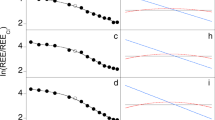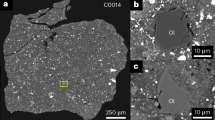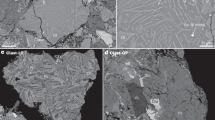Abstract
The hypothesis that a catastrophic impact of an extraterrestrial body caused the terminal Cretaceous mass extinctions of dinosaurs, planktonic foraminfera and other species is now accepted as respectable following the discovery of a worldwide iridium enrichment in the Cretaceous–Tertiary (K–T) boundary clay1–5. In the basal lamina of the K–T boundary clay of Caravaca (Spain)7 numerous spherules were discovered composed of finely crystallized, almost pure K-feldspar in the structural state of high sanidine. It is concluded here that these spherules solidified from a melt and were probably derived from the impacting body. This poses problems as high K-values are not reported from bulk analyses of meteorites6. The K-feldspar phenocrysts reported in some iron meteorites23 suggest the body may have been a metal–sulphide–silicate planetesimal. A cometary body is suggested as an alternative.
This is a preview of subscription content, access via your institution
Access options
Subscribe to this journal
Receive 51 print issues and online access
$199.00 per year
only $3.90 per issue
Buy this article
- Purchase on Springer Link
- Instant access to full article PDF
Prices may be subject to local taxes which are calculated during checkout
Similar content being viewed by others
References
Alvarez, L. W. et al. Science 208, 367–371 (1980).
Smit, J. & Hertogen, J. Nature 285, 198–200 (1980).
Ganapathy, R. Science 209, 921–923 (1980).
Kyte, F. T. et al. Nature 288, 651–656 (1980).
Hsü, K. J. Nature 285, 201–203 (1980).
Mason, B. Handbook of Elemental Abundances in Meteorites (Gordon and Breach, New York, 1973).
Smit, J. Proc. Kon. Ned. Akad. Wet. 80, B, 280–301 (1977).
Borg, I. Y. & Smith, D. K. Geol. Soc. Am. Mem. 122 (1969).
Palme, H. et al. Proc. 10th Lunar Sci. Conf. 2465–2492 (1979).
Lambert, P. Impact and Explosion Cratering, 449–460 (Pergamon, Oxford, 1977).
Smith, J. V. Feldspar Minerals (Springer, New York, 1974).
Van Hinte, J. E. Bull. Am. Ass. petrol. Geol. 60, 498–516 (1976).
Lofgren, G. in Physics of Magmatic Processes, 487–551 (Princeton University Press, 1980).
Kastner, M. Am. Miner. 56, 7–8, 1403–1442 (1971).
Baskin, Y. J. Geol. 64, 132–155 (1956).
Woodard, H. H. J. Geol. 80, 323–332 (1972).
Brus, Z. & Rieder, M. Acta univ. carol. 1, 37–45 (1975).
Lancelot et al. Init. Rep. DSDP Leg 11, 901–950 (1972).
Wright, T. L. Am. Miner. 53, 88–104 (1968).
O'Keefe, J. A. (ed.) Tektites (University of Chicago Press, 1963).
Parfenova, O. V. & Yakovlev, O. I. Impact and Explosion Cratering, 843–859 (Pergamon Oxford, 1977).
Blanchard, M. B. et al. Earth planet. Sci. Lett. 46, 178–190 (1980).
Wasserburg, G. J. et al. Science 161, 684–687 (1968).
Bandhari, N. & Shah, V. G. Proc. Ind. nat. Sci. Acad. A 45/3, 199–200 (1977).
Author information
Authors and Affiliations
Rights and permissions
About this article
Cite this article
Smit, J., Klaver, G. Sanidine spherules at the Cretaceous–Tertiary boundary indicate a large impact event. Nature 292, 47–49 (1981). https://doi.org/10.1038/292047a0
Received:
Accepted:
Issue Date:
DOI: https://doi.org/10.1038/292047a0
This article is cited by
-
Mineralogy and trace element chemistry of the siliceous earth of barmer basin, Rajasthan: Evidence for a volcanic origin
Journal of Earth System Science (2005)
-
Fe-rich and K-rich mafic spherules from slumped and channelized Chicxulub ejecta deposits in the northern La Sierrita area, NE Mexico
International Journal of Earth Sciences (2003)
-
Melt droplet formation in energetic impact events
Nature (1991)
-
Glass from the Cretaceous/Tertiary boundary in Haiti
Nature (1991)
Comments
By submitting a comment you agree to abide by our Terms and Community Guidelines. If you find something abusive or that does not comply with our terms or guidelines please flag it as inappropriate.



